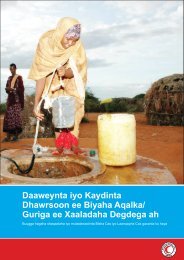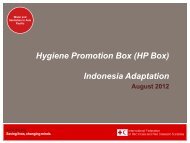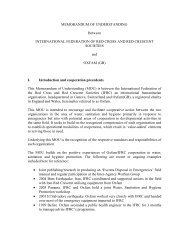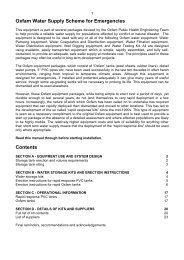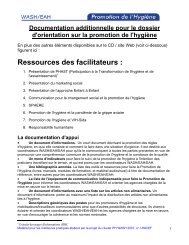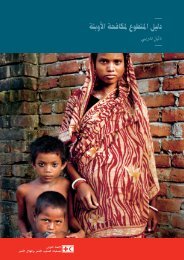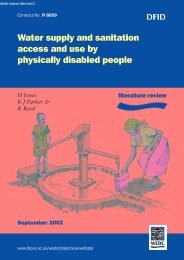Hygiene Promotion - IRC International Water and Sanitation Centre
Hygiene Promotion - IRC International Water and Sanitation Centre
Hygiene Promotion - IRC International Water and Sanitation Centre
You also want an ePaper? Increase the reach of your titles
YUMPU automatically turns print PDFs into web optimized ePapers that Google loves.
2. Target specific audiences.These may include mothers, children, older siblings, fathers, opinion leaders, or othergroups. One needs to identify who is involved in childcare, <strong>and</strong> who influences them ortakes decisions for them.3. Identify the motives for changed behaviour.These motives often have nothing to do with health. People may be persuaded to washtheir h<strong>and</strong>s so that their neighbours will respect them, so that their h<strong>and</strong>s smell nice, or forother motives. By working with the target groups one can discover their views of thebenefits of the safer hygiene practices. This provides the basis for a motivational strategy.4. <strong>Hygiene</strong> messages need to be positive.People learn best when they laugh, <strong>and</strong> will listen for a long time if they are entertained.Programmes, which attempt to frighten their audiences, will alienate them. There shouldtherefore be no mention of doctors, death or diarrhoea in hygiene promotion programmes.5. Identify appropriate channels of communication.We need to underst<strong>and</strong> how the target audiences communicate. For example, whatproportion of each listens to the radio, attends social or religious functions, or goes to thecinema? Traditional <strong>and</strong> existing channels are easier to use than setting up new ones, butthey can only be used effectively if their nature <strong>and</strong> capacity to reach people areunderstood.6. Decide on a cost-effective mix of channels.Several channels giving the same messages can reinforce one another. There is always atrade-off between reach, effectiveness <strong>and</strong> cost. Mass media reach many people cheaply,but their messages are soon forgotten. Face-to-face communication can be highly effectivein encouraging behaviour change, but tends to be very expensive per capita.7. <strong>Hygiene</strong> promotion needs to be carefully planned, executed, monitored <strong>and</strong>evaluated.At a minimum, information is required at regular intervals on the outputs (e.g. how manybroadcasts, house visits, etc.), <strong>and</strong> the population coverage achieved (e.g. what proportionof target audiences heard a broadcast?). Finally, indicators of the impact on the targetbehaviours must be collected.These fallacies <strong>and</strong> key principles have been abstracted from the WELL Fact Sheet on<strong>Hygiene</strong> <strong>Promotion</strong>. The complete document is online available(http://www.lboro.ac.uk/orgs/well/resources/fact-sheets/fact-sheets-htm/hp.htm).<strong>IRC</strong> <strong>International</strong> <strong>Water</strong> <strong>and</strong> <strong>Sanitation</strong> <strong>Centre</strong> 75



